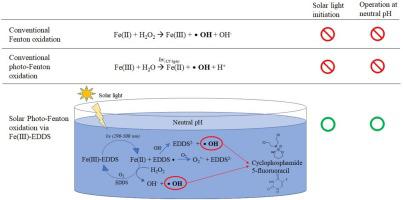Journal of Water Process Engineering ( IF 7 ) Pub Date : 2021-04-10 , DOI: 10.1016/j.jwpe.2021.102066 Hank Hui-Hsiang Lin , Angela Yu-Chen Lin

|
Cytostatic drugs have been widely and increasingly used and are poorly biodegraded in wastewater treatment plants, so they are commonly found in wastewater effluents. This study applied a solar photo-Fenton process to remove cyclophosphamide and 5-fluorouracil. The complex Fe(III)-ethylenediamine-N,N’-disuccinic (EDDS) degraded cyclophosphamide and 5-fluorouracil more efficiently than three other Fe(III)-ligand complexes under ultraviolet (UV) and solar light irradiation. Fe(III)-EDDS also showed higher photoreactivity under solar light than under UV light. Cyclophosphamide and 5-fluorouracil showed increasing degradation with increasing Fe(III)-EDDS concentration and H2O2 dosage. The addition of EDDS can widen the operational pH range of the solar photo-Fenton process to pH 3.0−8.5. A suitable Fe(III):EDDS ratio and initial dissolved oxygen level were demonstrated to affect the degradation performance. Cyclophosphamide and 5-fluorouracil were rapidly degraded within 1.5 min (k = 5.131 and 5.407 min−1, respectively) in the solar photo-Fenton process with the concentration of 0.1 mM Fe(III)-EDDS and 1 mM H2O2, and detoxification throughout the process was also ensured. In addition, this study is the first to combine the UV/H2O2 process with the solar photo-Fenton process to achieve the goal of total mineralization. For engineering purposes, this solar photo-Fenton process with a relatively low Fe(III) concentration and H2O2 dosage provides a promising potential alternative method for wastewater treatment under natural pH conditions with solar light.
中文翻译:

在水性环境中,在环境pH下,通过Fe(III)-EDDS通过光电子Fenton氧化抑制细胞生长的药物
细胞抑制药物已被广泛使用,并且在废水处理厂中的生物降解性很差,因此通常在废水中发现。这项研究应用了太阳光芬顿法去除环磷酰胺和5-氟尿嘧啶。Fe(III)-乙二胺-N,N'-二琥珀酸(EDDS)配合物在紫外线(UV)和日光照射下比其他三种Fe(III)-配体配合物更有效地降解了环磷酰胺和5-氟尿嘧啶。Fe(III)-EDDS在太阳光下也显示出比在紫外线下更高的光反应性。环磷酰胺和5-氟尿嘧啶显示随着Fe(III)-EDDS浓度和H 2 O 2的增加而降解增加剂量。EDDS的添加可以将太阳光芬顿法的操作pH范围扩大到pH 3.0-8.5。已证明合适的Fe(III):EDDS比和初始溶解氧水平会影响降解性能。在太阳光芬顿法中,浓度为0.1 mM Fe(III)-EDDS和1 mM H 2 O 2时,环磷酰胺和5-氟尿嘧啶在1.5分钟内迅速降解(分别为k = 5.131和5.407 min -1),并且在整个过程中也确保了排毒。此外,这项研究是第一个结合UV / H 2 O 2的研究用太阳光芬顿法工艺实现总矿化的目的。出于工程目的,这种具有相对较低的Fe(III)浓度和H 2 O 2剂量的太阳光芬顿法为在自然pH条件下用太阳光处理废水提供了一种有希望的潜在替代方法。



























 京公网安备 11010802027423号
京公网安备 11010802027423号